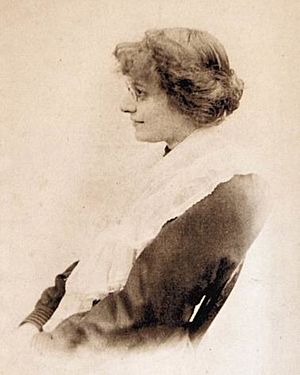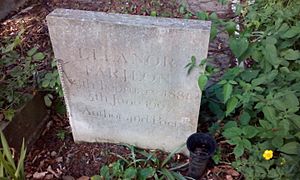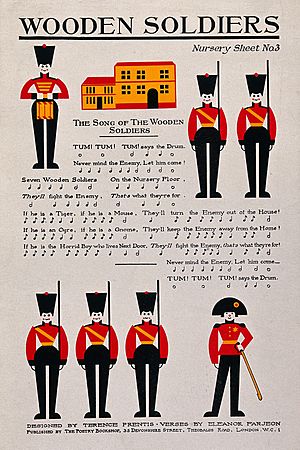Eleanor Farjeon facts for kids
Quick facts for kids
Eleanor Farjeon
|
|
|---|---|

Farjeon in 1899
|
|
| Born | Eleanor Farjeon 13 February 1881 Strand, London, England |
| Died | 5 June 1965 (aged 84) Hampstead, London, England |
| Pen name | Tomfool, Merry Andrew, Chimaera |
| Nationality | British |
| Period | 1908–58 |
| Genre | Children's literature |
| Notable works | Morning Has Broken |
| Notable awards | Carnegie Medal 1955 Hans Christian Andersen Award 1956 |
Eleanor Farjeon (born February 13, 1881 – died June 5, 1965) was an English writer. She wrote many different kinds of books. These included stories and plays for children, poems, and even biographies about real people. She also wrote about history and current events.
Some of her books had beautiful pictures drawn by Edward Ardizzone. Eleanor Farjeon won many important literary awards. There is even an award named after her, the Eleanor Farjeon Award. It is given every year to people who do great work for children's books. Her brother, Joseph Jefferson Farjeon, was also a writer, known for his mystery stories.
About Eleanor Farjeon
Eleanor Farjeon was born in London, England, on February 13, 1881. Her family was very creative. Her father, Benjamin Farjeon, was a writer. Her two younger brothers, Joseph and Herbert Farjeon, also became writers. Her oldest brother, Harry Farjeon, became a composer, someone who writes music.
Eleanor, who her family called "Nellie," was a shy child. She wasn't very strong and had trouble seeing. She learned everything at home. She spent a lot of time in the attic, surrounded by many books. Her father encouraged her to write from when she was just five years old. She wrote about her childhood and family in her book, A Nursery in the Nineties.
She and her brother Harry were especially close. When Eleanor was five, they started a long-running pretend game. They would act out different characters from plays and books. This game, called T.A.R., lasted until they were in their mid-twenties. Eleanor said this game helped her write easily and enjoyably.
Eleanor lived among writers and theater people in London. But much of her ideas came from her childhood. Family holidays also gave her inspiration. A trip to France in 1907 gave her the idea for a story about a traveling singer. This later became her most famous book, Martin Pippin in the Apple Orchard.
Some of her first published works were a book of poems called Pan Worship (1908). She also wrote Nursery Rhymes of London Town (1916). During World War I, her family moved to Sussex, a county in England. The beautiful countryside and local traditions there greatly influenced her later writing. Her Martin Pippin stories are set in Sussex.
When she was eighteen, Eleanor wrote the words for a short opera called Floretta. Her older brother Harry wrote the music for it. She also worked with her youngest brother, Herbert. He was an expert on Shakespeare and wrote about plays. Together, they created plays like Kings and Queens (1932) and The Glass Slipper (1944).
Eleanor Farjeon had many talented friends who were also writers. These included D.H. Lawrence, Walter de la Mare, and Robert Frost. For several years, she was very good friends with the poet Edward Thomas and his wife. After Edward Thomas died in a war in 1917, Eleanor stayed close with his wife, Helen. Eleanor later published many of their letters. She also wrote a book about their friendship called Edward Thomas: The Last Four Years (1958).
After World War I, Eleanor made a living by writing poems, working as a journalist, and broadcasting on the radio. She often used pen names like Tomfool or Merry Andrew. Her poems appeared in many newspapers and magazines. Her writings about current events for The Herald and The New Leader were very well-known.
Eleanor Farjeon never married. She had a thirty-year friendship with George Earle, who was an English teacher. After he passed away in 1949, she became good friends with the actor Denys Blakelock. He later wrote a book about their friendship.
In 1951, she became a Roman Catholic. In the 1950s, she won three major literary awards. She won the 1955 Carnegie Medal for British children's books. She also received the first ever Hans Christian Andersen Award in 1956. Both awards were for her book The Little Bookroom. In 1959, she received the first Regina Medal for her lasting contributions to children's literature.
In 1960, Eleanor gave her family's book collection to the Dunedin Public Library. Her father had been a journalist there before returning to England. The collection includes books by Eleanor, her father, brothers, and niece. It also has music, photos, and letters.
Eleanor Farjeon died in Hampstead, London, on June 5, 1965. She is buried in a churchyard there.
The Children's Book Circle, a group of publishers, gives out the Eleanor Farjeon Award every year. It honors people or groups who have made outstanding contributions to children's books.
The famous Japanese animator Hayao Miyazaki has said that Eleanor Farjeon's work influenced him. Eleanor had planned to write more books about her life. But she passed away before she could finish them. Her niece, Annabel Farjeon, later used Eleanor's unfinished writings in her own book about her aunt, Morning has Broken (1986).
Her Writings
Eleanor Farjeon's most famous work is the hymn "Morning Has Broken". She wrote it in 1931 to an old Scottish tune. In 1971, the singer Cat Stevens performed it, and it became a huge international hit. She also wrote the Christmas carol "People, Look East!". Children's choirs often sing this song.
She also wrote for a BBC radio show called "Have you brought your music?".
Eleanor Farjeon's plays for children were very popular in schools during the 1950s and 60s. They were easy for young children to perform and for teachers to direct. Some plays had many small parts, so a whole class could take part. Others had only a few characters.
Her books include Martin Pippin in the Apple Orchard (1921) and its sequel, Martin Pippin in the Daisy Field (1937). These stories were inspired by her trip to France. But they are set in Sussex, England. They describe real villages and places like the chalk cliffs.
In Apple Orchard, a traveling singer named Martin Pippin meets a sad farmer. The farmer asks him to visit an orchard where his girlfriend is locked up. Six young women are guarding her. Martin Pippin goes to help. He tells the young women love stories to earn their trust. Even though it seems like a children's book, the six love stories were written for a young soldier. They are like fairy tales, but they talk about losing someone you love, being betrayed, and wishing for love.
The sequel, Martin Pippin in the Daisy Field, is about six little girls. Martin entertains them while they make daisy chains. The six stories in this book were written for children. One of them, Elsie Piddock Skips in her Sleep, is considered one of Eleanor Farjeon's best stories. It has even been published on its own.
The Little Bookroom is a collection of stories she thought were her best. It was published in 1955 with pictures by Edward Ardizzone. Eleanor won the Carnegie Medal for this book. This award is given to the best children's book by a British writer each year. She also received the first international Hans Christian Andersen Award in 1956. This award is now seen as the highest honor for children's book creators.
The famous writer Stephen Fry said that Eleanor Farjeon's poems for children were "hardy annuals from the garden of English verse." This means they are classic and loved poems, like those by A. A. Milne and Lewis Carroll.
Selected Books
- Pan-Worship and Other Poems (1908)
- Nursery Rhymes of London Town (1916)
- Martin Pippin in the Apple Orchard (1921)
- Tales from Chaucer: The Canterbury Tales Done in Prose (1930)
- The Old Nurse's Stocking Basket (1931)
- Kings and Queens (1932), with Herbert Farjeon
- Martin Pippin in the Daisy Field (1937)
- The Little Bookroom (1955)
- The Children's Bells (1957), a collection of her poems and hymns
See also
 In Spanish: Eleanor Farjeon para niños
In Spanish: Eleanor Farjeon para niños



